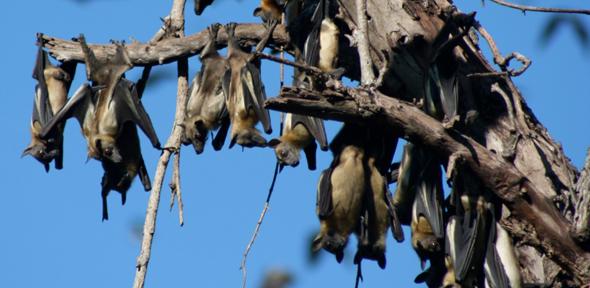Clik here to view.

The study, conducted jointly by the University of Cambridge and the Zoological Society of London’s Institute of Zoology and published today in the journal Nature Communications, found that the “gregarious” bats span over 4,500 km of central Africa (around the distance from California to New York). The researchers also discovered that thirty-four per cent of the bats had been infected with Lagos bat virus, a disease similar to rabies, and 42 per cent had been infected with henipaviruses.
The African straw-coloured fruit bat (Eidolon helvum), which can live in roosts of over one million and often congregates near cities, was previously known to be a reservoir for these viruses, but it was not known to what extent.
For the study, the researchers tested over 2,000 bats in 12 different countries across Africa, measuring DNA from blood and tissue samples. They discovered that the bats were largely genetically similar, meaning that they travelled and mated across the continent without any evidence of population subgroups or specific migratory patterns – the largest example of this freely mixing population structure ever found in mammals. The species’ homogeneity and extensive movement means that the two viruses can be spread easily.
Professor James Wood, the study’s senior author from the University of Cambridge’s Department of Veterinary Medicine, said: “We now not only know how widespread viral infections are in this bat population, but we also know much more about its population structure. This new information indicates that the unique population of freely mixing bats across the entire continent facilitates the spread of the viruses. This has important implications for the monitoring of these viruses in order to prevent its spread to other animals, including humans.”
Fruit bats are often hunted for meat, a process which can result in a spill-over of these pathogens from animals to humans. Henipaviruses can also be spread through contact with urine and faeces. While no instances of either disease have been reported in humans in Africa, the viruses have previously been detected in pigs in Ghana. Henipaviruses have caused fatal disease in humans, pigs and horses in SE Asia and Australia.
Although potential human infection raises public health concerns, the study’s lead author, Dr Alison Peel, cautions restraint. She said: “Sometimes, a knee-jerk response can be to try and remove bats from urban areas via culling or dispersal. However, there is evidence to suggest that actions such as this can stress the bats and lead to a greater risk of spill-over. The most appropriate response is ongoing studies and public awareness to avoid handling bats, and to wash the wound thoroughly if you are bitten by a bat.”
A population of fruit bats which is found across much of continental Africa is widely infected with two deadly viruses that could spread to humans, new research reveals.
Image may be NSFW.
Clik here to view.
This work is licensed under a Creative Commons Licence. If you use this content on your site please link back to this page.